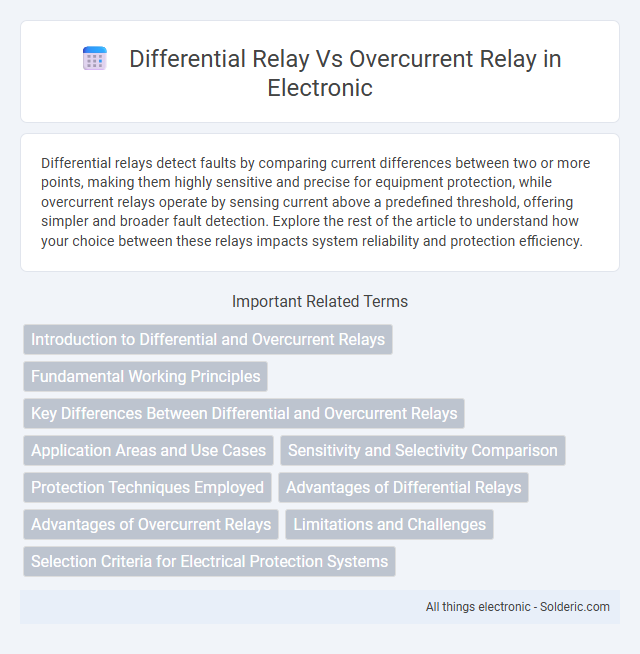Differential relays detect faults by comparing current differences between two or more points, making them highly sensitive and precise for equipment protection, while overcurrent relays operate by sensing current above a predefined threshold, offering simpler and broader fault detection. Explore the rest of the article to understand how your choice between these relays impacts system reliability and protection efficiency.
Comparison Table
| Feature | Differential Relay | Overcurrent Relay |
|---|---|---|
| Function | Detects difference in current between two or more points | Operates when current exceeds a preset value |
| Application | Protection of transformers, generators, busbars | Protection of feeders, lines, transformers against overcurrent |
| Sensitivity | High; detects internal faults accurately | Moderate; detects overloads and short circuits |
| Operation Principle | Compares incoming and outgoing currents to identify faults | Measures current magnitude and triggers relay if threshold exceeded |
| Fault Detection | Internal faults within protected zone | External and internal faults causing high current |
| Speed | Fast operation for immediate fault isolation | Relatively slower, time delayed in long-time overcurrent relays |
| Complexity | More complex, requires current transformers at multiple points | Simple design, uses single current transformer |
| Cost | Higher due to complexity and installation requirements | Lower, economical and widely used |
| Typical Usage Zones | Zones with sensitive equipment like transformers and generators | General line and feeder protection |
Introduction to Differential and Overcurrent Relays
Differential relays operate by comparing the current entering and leaving a protected zone, detecting faults through current imbalances to ensure precise fault localization. Overcurrent relays activate when current exceeds a preset threshold, offering protection against overloads and short circuits in electrical systems. Your choice between these relays depends on the specific protection needs, system configuration, and sensitivity required for fault detection.
Fundamental Working Principles
Differential relays operate by comparing the current entering and leaving a protected zone, tripping when a difference exceeds a preset threshold, indicating internal faults. Overcurrent relays function by detecting current magnitudes that surpass a predefined limit, responding primarily to overload or short-circuit conditions. The fundamental difference lies in differential relays' sensitivity to internal fault currents versus overcurrent relays' focus on current magnitude irrespective of fault location.
Key Differences Between Differential and Overcurrent Relays
Differential relays operate based on the difference in current between two or more points in a circuit, making them highly sensitive to internal faults within equipment like transformers or generators. Overcurrent relays function by detecting current levels exceeding a predetermined threshold, providing protection against overloads and external faults in power systems. Differential relays offer selective protection with faster fault detection and minimal nuisance tripping compared to overcurrent relays, which provide broader but less precise coverage.
Application Areas and Use Cases
Differential relays are primarily used in protecting transformers, generators, and large motors by detecting faults within specific zones through current comparison. Overcurrent relays find widespread application in distribution systems, feeders, and backup protection due to their sensitivity to current magnitude exceeding preset thresholds. Your choice depends on the criticality of the equipment and the precision required in fault detection, with differential relays offering superior protection in localized zones and overcurrent relays serving broader network safeguarding.
Sensitivity and Selectivity Comparison
Differential relays exhibit higher sensitivity by detecting minute differences in current between two points, allowing them to identify faults within a protected zone with precision. Overcurrent relays rely on current magnitude exceeding a preset threshold, making them less sensitive to internal faults but effective for general fault detection on a wider system reach. Selectivity in differential relays is superior due to their ability to isolate faults within specific equipment, while overcurrent relays may lack such discrimination, potentially causing unnecessary tripping of upstream or downstream devices.
Protection Techniques Employed
Differential relays protect electrical equipment by comparing current entering and leaving a zone, triggering a trip when discrepancies indicate faults within that zone. Overcurrent relays operate by detecting currents exceeding preset thresholds, primarily safeguarding circuits from excessive current due to overloads or short circuits. Your choice between these protection techniques depends on the required sensitivity and fault detection specificity in the electrical system.
Advantages of Differential Relays
Differential relays offer precise fault detection by comparing currents at two or more points, minimizing false trips caused by external faults or load changes. Their sensitivity allows for quick isolation of internal faults, enhancing system protection and reducing downtime. You benefit from improved reliability and selectivity compared to traditional overcurrent relays, which primarily respond to current magnitude without considering current direction or phase differences.
Advantages of Overcurrent Relays
Overcurrent relays offer simple design and cost-effective protection, making them suitable for a wide range of applications, especially in distribution systems. They provide reliable fault detection by responding to excess current levels, ensuring quick disconnection of faulty circuits to minimize equipment damage. Their adaptability to different time-current characteristics allows precise coordination with other protective devices, enhancing system selectivity and stability.
Limitations and Challenges
Differential relays provide precise fault detection by comparing current differences but face challenges with CT saturation and sensitivity to inrush currents, limiting their reliability in certain load conditions. Overcurrent relays, while simpler and more cost-effective, struggle with coordination and selectivity, often leading to nuisance tripping during transient overloads. Understanding these limitations helps you select the appropriate relay type for specific protection schemes and system stability.
Selection Criteria for Electrical Protection Systems
Differential relays provide precise protection by detecting differences in current between two or more points, making them ideal for protecting transformers, generators, and motors from internal faults. Overcurrent relays respond to excessive current flow regardless of the fault location, making them suitable for protecting distribution lines and feeders against overloads and faults. Your selection should consider the protection scope, sensitivity, speed of response, and system complexity to ensure optimal coordination and reliability.
Differential relay vs overcurrent relay Infographic

 solderic.com
solderic.com